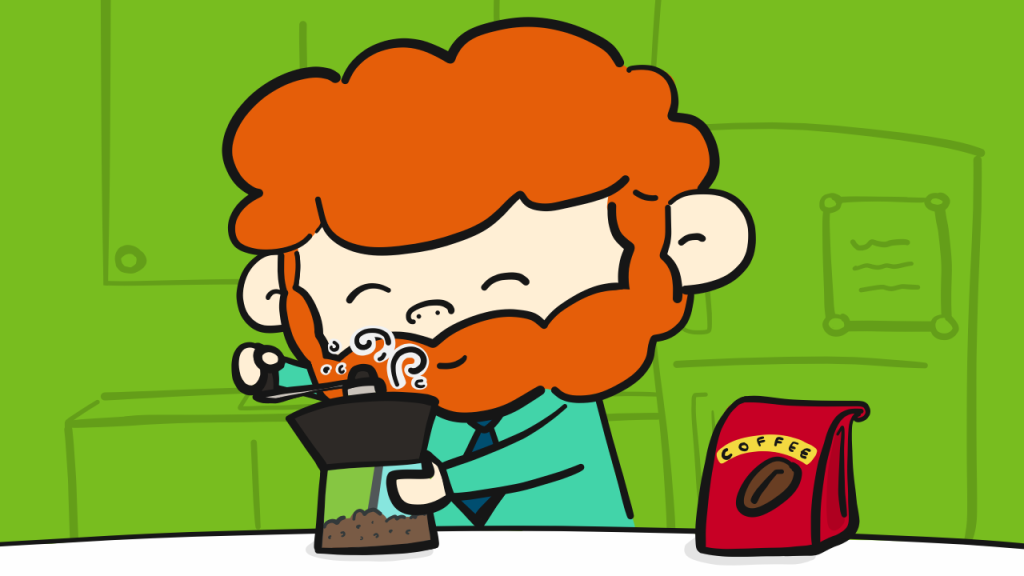Coffee made from just ground coffee beans is a great way to prepare for a productive day ahead. It fits your schedule because it only takes a few seconds to grind whole beans in a quality coffee grinder. For that little time and effort, the lingering effects of coffee comfort lasts all day long.
-
Pick a coffee grinder to match your breakroom decor, size and usage demands
- Kitchen decor – Appliances that complement the surroundings are easiest for staff to accept into their daily routine. For example, if other appliances are stainless steel, look for a silver tone coffee grinder to match.
- Kitchen size – Coffee grinders come in a variety of sizes to fit most any size kitchen and corresponding available counter space. Office kitchens become more streamlined and accessible when the appliances fit the space without being too large or too small.
- Employee usage – Consider the bowl or coffee ground container size. You’ll want to grind just enough coffee as needed so it’s fresh. For example, a coffee grinder’s bowl or ground container that holds 3.2 ounces of coffee beans or 90 grams of beans makes enough grounds for 18 cups of coffee. Another type of grinder may hold enough beans to make grounds for 32 cups of coffee.
-
Consider how the coffee is ground
Coffee grinders grind the coffee beans using different methods. Each has its pros and cons.
Blade coffee grinder
A blade grinder has a propeller-like blade at the bottom of the bowl, somewhat like the blade in a blender.
The advantages of the blade grinder is that it’s inexpensive compared to burr grinders. Blade grinders are also more compact in size, which make them an excellent choice for small spaces.
The disadvantage is the operation. To get a more consistent ground texture, you must pulse in intervals instead of all at once.
Burr coffee grinder
A burr grinder has two (scratchy exteriors) burrs that spin. The coffee beans go in between them and are ground a little at a time.
The advantages of burr grinders are more uniform fine texture ground. Burr grinders also have several different grind settings from extra fine to coarse. Burr grinders can grind coffee beans fast in one instance instead of several pulses.
A blade style or burr grinder, whichever you choose, freshly ground beans from your coffee grinder will be much more flavorful than those pre-ground in a can or bag.
-
Decide if a commercial grade coffee grinder is best for your office
Any size office with discriminating tastes might prefer a commercial grade burr grinder. Smaller capacity blade grinders will do the job though for small offices. If you find your small office of 10 or less is grinding coffee more often than desired, you might want to upgrade to a commercial grade burr grinder.
-
Stay within budget without skimping on quality
When it comes to staying on budget, buy the best coffee grinder you can afford. Factor in the type of coffee your coworkers drink. Note that burr grinders typically cost more than blade grinders; however, whatever style meets your office needs is the best choice.
With so many options, you can find the right coffee grinder within your budget.
-
Consider the ease of operation
Coffee grinders that are easy to handle while operating are best. Some coffeemakers include built-in coffee grinders. This is convenient because the coffeemaker can be programmed to grind coffee beans and make coffee automatically. There are also very simple inexpensive hand-held manual coffee grinders.
-
Look at safety features
Most coffee grinders come equipped with a built in safety lock. This feature keeps the appliance from operating when the lid is ajar. Before turning the grinder on, place it on a flat, even surface and secure the lid to the coffee bean container.
-
Consider the warranty
Manufacture warranties for coffee grinders typically range from 1 year to 18 months from the date of purchase. Since you’ll likely use your coffee grinder five days a week, a warranty, whether from the manufacturer or store, is a wise way to protect your investment.
Note that all warranties have exclusions. For example, in many cases, neglecting recommended maintenance on a product voids out its warranty.
-
Think over the maintenance requirements
Look for coffee grinders with low maintenance requirements. It’s nice to have effortless cleaning of the bowl or coffee ground chamber, bean hopper or bean container, conical burrs, and the area around the blades—where beans could get stuck.
Some of the removable parts, such as the bean container, may be dishwasher safe. Whatever features are important to you, keep them in mind as you shop.
Purchasing coffee beans for your coffee grinder
Freshness and grinding texture customization are two main benefits of purchasing whole coffee beans. Choose from espresso style, decaf medium roast, Verona whole bean, and other flavors to suit you and your coworkers tastes.
Tips for grinding coffee beans
For a more structured bean to cup ratio, use two tablespoons of coffee beans per cup. Test it. You can always make adjustments for a stronger or weaker brew.
The motor causes a grinder to heat up quickly. As a general rule of thumb, grind in short 10-15 second intervals for even distribution. Wait 3-5 minutes between pulses to keep the machine from overheating. It could take up to 60 seconds to obtain a fine textured coffee ground to make espresso, for instance.
Storing coffee beans
To maintain optimum freshness, place each bag of coffee beans in a dark airtight container to double seal. Store them in a cool, dry place, away from light. Storage cabinets work well. Countertops are ideal too as long as they are far from ovens or microwaves. Because moisture spoils coffee’s freshness, the best recommended storage areas are free from dampness. Make it a faithful habit: grind coffee beans daily and use the grounds immediately.



